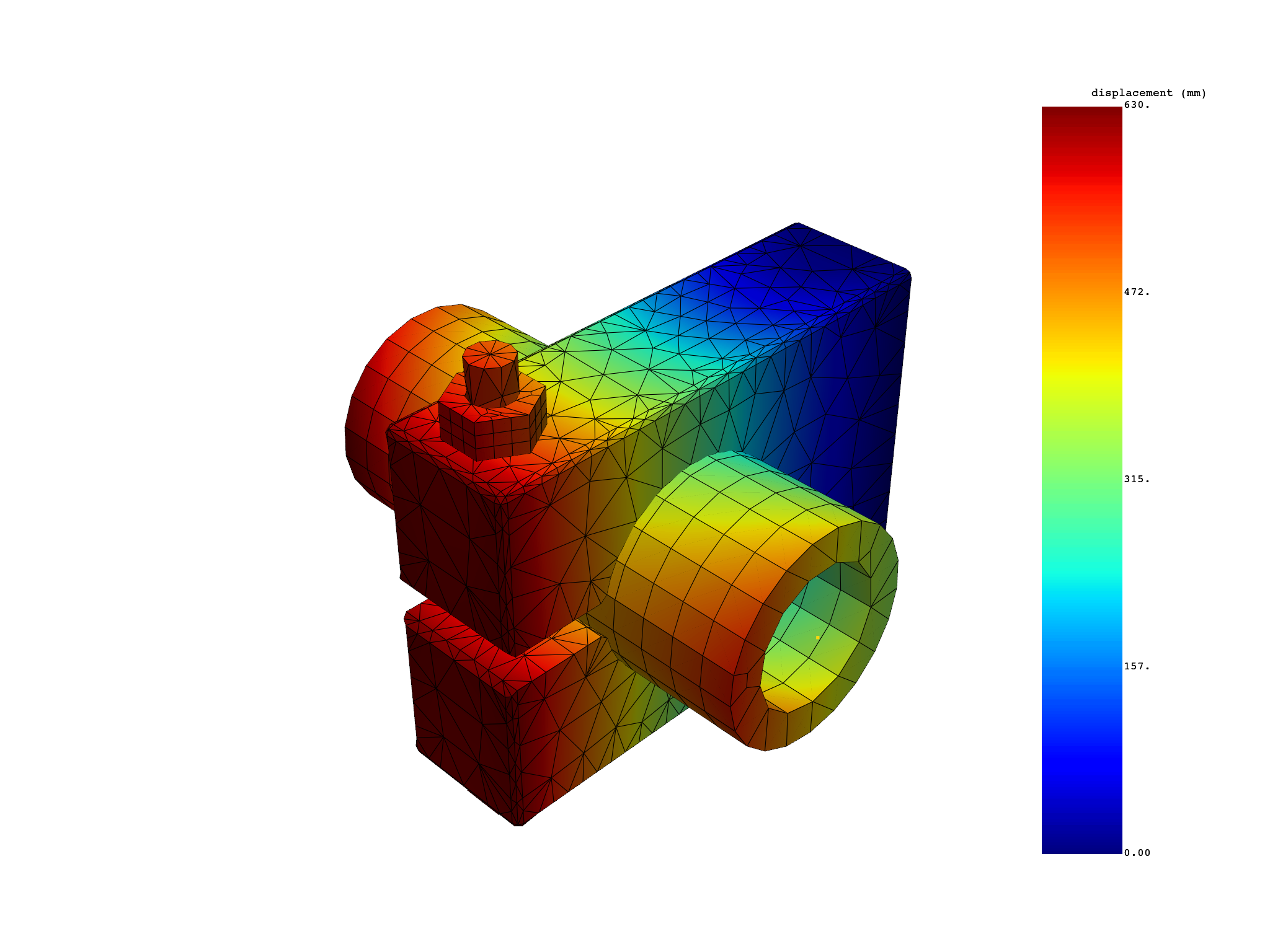Note
Go to the end to download the full example code.
Explore the data of a result with the dataframe (harmonic simulation)#
This example uses a harmonic simulation to show how to interact with the PyDPF-Post dataframe, which is the object returned by each result.
Perform required imports#
Perform required imports. This example uses a supplied file that you can
get by importing the DPF examples package.
from ansys.dpf import post
from ansys.dpf.post import examples
Get Simulation object#
Get the Simulation object that allows access to the result. The Simulation
object must be instantiated with the path for the result file. For example,
"C:/Users/user/my_result.rst" on Windows or "/home/user/my_result.rst"
on Linux.
example_path = examples.download_harmonic_clamped_pipe()
# to automatically detect the simulation type, use:
simulation = post.load_simulation(example_path)
# to enable auto-completion, use the equivalent:
simulation = post.HarmonicMechanicalSimulation(example_path)
Extract displacement over all sets#
displacement = simulation.displacement(all_sets=True)
print(displacement)
type(displacement)
results U ...
set_ids 1 2 3 ...
complex 0 1 0 1 0 1 ...
node_ids components ...
3548 X 9.3929e+01 0.0000e+00 -5.2330e+01 0.0000e+00 -1.1203e+01 0.0000e+00 ...
Y -4.3312e+02 0.0000e+00 1.8810e+02 0.0000e+00 6.8681e+01 0.0000e+00 ...
Z 9.6172e-01 0.0000e+00 -1.3049e+01 0.0000e+00 2.3508e+01 0.0000e+00 ...
3656 X 1.0516e+02 0.0000e+00 -5.8461e+01 0.0000e+00 -1.4575e+01 0.0000e+00 ...
Y -4.6059e+02 0.0000e+00 2.0315e+02 0.0000e+00 7.4665e+01 0.0000e+00 ...
Z 9.4728e-01 0.0000e+00 -1.3728e+01 0.0000e+00 2.5207e+01 0.0000e+00 ...
... ... ... ... ... ... ... ... ...
Loop over all columns and rows to understand the dataframe and get the values for each index.
# columns
for column in displacement.columns:
print(f'Column with label "{column.name}" and available values {column.values}.')
# rows
for row in displacement.index:
print(f'Row with label "{row.name}" and available values {row.values}.')
Column with label "results" and available values ['U'].
Column with label "set_ids" and available values [1, 2, 3, 4, 5].
Column with label "complex" and available values [0, 1].
Row with label "node_ids" and available values [3548 3656 4099 ... 3260 9942 9943].
Row with label "components" and available values ['X', 'Y', 'Z'].
Make selections in dataframe#
Use the labels and values shown by the preceding code to select subparts of the dataframe.
all_real_values = displacement.select(complex=0)
print(all_real_values)
all_imaginary_values = displacement.select(complex=1)
print(all_imaginary_values)
sets_values = displacement.select(set_ids=[1, 2])
print(sets_values)
node_values = displacement.select(node_ids=[3548])
print(node_values)
results U
set_ids 1 2 3 4 5
complex 0
node_ids components
3548 X 9.3929e+01 -5.2330e+01 -1.1203e+01 -1.1510e+01 -1.4457e+01
Y -4.3312e+02 1.8810e+02 6.8681e+01 2.2900e+01 -6.6765e+00
Z 9.6172e-01 -1.3049e+01 2.3508e+01 1.4745e+00 -5.9568e+00
3656 X 1.0516e+02 -5.8461e+01 -1.4575e+01 -1.3822e+01 -1.7782e+01
Y -4.6059e+02 2.0315e+02 7.4665e+01 2.7874e+01 1.5223e+00
Z 9.4728e-01 -1.3728e+01 2.5207e+01 1.4487e+00 -7.3947e+00
... ... ... ... ... ... ...
results U
set_ids 1 2 3 4 5
complex 1
node_ids components
3548 X 0.0000e+00 0.0000e+00 0.0000e+00 0.0000e+00 0.0000e+00
Y 0.0000e+00 0.0000e+00 0.0000e+00 0.0000e+00 0.0000e+00
Z 0.0000e+00 0.0000e+00 0.0000e+00 0.0000e+00 0.0000e+00
3656 X 0.0000e+00 0.0000e+00 0.0000e+00 0.0000e+00 0.0000e+00
Y 0.0000e+00 0.0000e+00 0.0000e+00 0.0000e+00 0.0000e+00
Z 0.0000e+00 0.0000e+00 0.0000e+00 0.0000e+00 0.0000e+00
... ... ... ... ... ... ...
results U
set_ids 1 2
complex 0 1 0 1
node_ids components
3548 X 9.3929e+01 0.0000e+00 -5.2330e+01 0.0000e+00
Y -4.3312e+02 0.0000e+00 1.8810e+02 0.0000e+00
Z 9.6172e-01 0.0000e+00 -1.3049e+01 0.0000e+00
3656 X 1.0516e+02 0.0000e+00 -5.8461e+01 0.0000e+00
Y -4.6059e+02 0.0000e+00 2.0315e+02 0.0000e+00
Z 9.4728e-01 0.0000e+00 -1.3728e+01 0.0000e+00
... ... ... ... ... ...
results U ...
set_ids 1 2 3 ...
complex 0 1 0 1 0 1 ...
node_ids components ...
3548 X 9.3929e+01 0.0000e+00 -5.2330e+01 0.0000e+00 -1.1203e+01 0.0000e+00 ...
Y -4.3312e+02 0.0000e+00 1.8810e+02 0.0000e+00 6.8681e+01 0.0000e+00 ...
Z 9.6172e-01 0.0000e+00 -1.3049e+01 0.0000e+00 2.3508e+01 0.0000e+00 ...
Make selections in dataframe by index#
To select values by index for each label, use the iselect() method.
The index to ID order follows what is returned by the values on the preceding index method.
sets_values = displacement.iselect(set_ids=0)
print(sets_values)
node_values = displacement.iselect(node_ids=[0])
print(node_values)
results U
set_ids 1
complex 0 1
node_ids components
3548 X 9.3929e+01 0.0000e+00
Y -4.3312e+02 0.0000e+00
Z 9.6172e-01 0.0000e+00
3656 X 1.0516e+02 0.0000e+00
Y -4.6059e+02 0.0000e+00
Z 9.4728e-01 0.0000e+00
... ... ... ...
results U ...
set_ids 1 2 3 ...
complex 0 1 0 1 0 1 ...
node_ids components ...
3548 X 9.3929e+01 0.0000e+00 -5.2330e+01 0.0000e+00 -1.1203e+01 0.0000e+00 ...
Y -4.3312e+02 0.0000e+00 1.8810e+02 0.0000e+00 6.8681e+01 0.0000e+00 ...
Z 9.6172e-01 0.0000e+00 -1.3049e+01 0.0000e+00 2.3508e+01 0.0000e+00 ...
Make multiple selections in dataframe#
real_values_for_one_set_onde_node = displacement.select(
node_ids=[3548], set_ids=1, complex=0
)
print(real_values_for_one_set_onde_node)
results U
set_ids 1
complex 0
node_ids components
3548 X 9.3929e+01
Y -4.3312e+02
Z 9.6172e-01
Make selections to plot dataframe#
displacement.plot(set_ids=1, complex=0)

(None, <pyvista.plotting.plotter.Plotter object at 0x7f3f77b044c0>)
Total running time of the script: (0 minutes 1.019 seconds)

